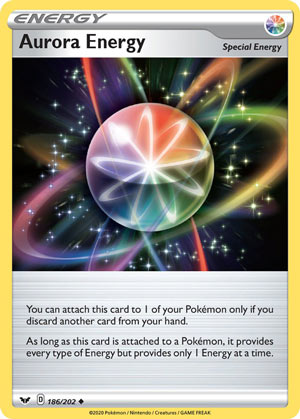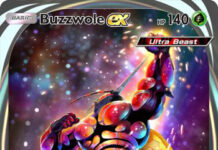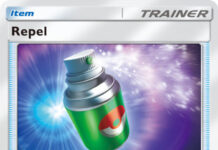
Aurora Energy
– Sword & Shield
Date Reviewed:
February 18, 2020
Ratings Summary:
Standard: 4.17
Expanded: 4.17
Limited: 4.50
Ratings are based on a 1 to 5 scale. 1 is horrible. 3 is average. 5 is great.
Reviews Below:
 Otaku Are you sick of new cards that are tweaked versions of older cards? I hope not, because Aurora Energy (Sword & Shield 186/202) is our fourth-place pick! This Special Energy card has the familiar effect of providing one unit of Energy that simultaneously counts as all Types, at least, once it is attached to one of your Pokémon. In order to attach Aurora Energy, you must discard a card from your hand. Aurora Energy already has two rulings, from the Sword 7 Shield FAQ provided to Pre-Release events. == AURORA ENERGY (SS:Sword & Shield) Q. Can you use Frosmoth’s “Ice Dance” Ability to attach Aurora Energy? A. No. Because Aurora Energy does not count as any type while it is in your hand. So you can attach Aurora Energy with an effect that attaches any Energy card or Special Energy card, and when attaching Aurora Energy from your deck, discard pile, Prizes, or moving it from one Pokémon to another, you do not need to discard a card from your hand. This kind of effect isn’t new, as it goes all the way back to Rainbow Energy, first released in the Team Rocket expansion back in 2000! Its exact effect has been tweaked over time, but it has always provided one unit of Energy that counted as all Types, at least, when attached to a Pokémon. The modern version has you place a damage counter onto the Pokémon to which you attach Rainbow Energy from hand. As with Aurora Energy, you cannot attach Rainbow Energy with a Type-specific effect, because it has no Type while in hand, and you don’t suffer its “activation cost” (the damage counter placement) if you attach Rainbow Energy from some place other than your hand. I’m spending a lot of time and space talking about Rainbow Energy. Why? First, Rainbow Energy – and the other similar Special Energy cards – have proven that this kind of effect is often great, and sometimes boarders on game-breaking. Maybe you just need to splash in something that is mostly off-Type, maybe you’re running a multi-Type deck, maybe you’re running something that copies attacks but with their Energy costs… and there are even some decks where the Special Energy’s drawback is actually helpful. Aurora Energy’s discard cost can leave it dead in hand, but wanting certain cards in your discard pile is at worst uncommon. Wanting a damage counter on something is actually pretty rare, though some successful decks have indeed relied on Rainbow Energy for that reason! What I’m getting at is that
Yeah, up to eight Special Energy cards that can meet any Type requirement, in a single deck! I don’t know how often it will be necessary, but I am betting it will matter sooner or later. Expanded has more combos and counters for Aurora Energy, as well as more competition… but as with Rainbow Energy, other similar Special Energy cards may end up being used with Aurora Energy, and not just instead of it. As for the Limited Format, you usually have to run a multi-Type deck, and you’ll probably have plenty of filler to discard, so Aurora Energy is pretty great. The real catch here is getting it into your hand at the right time; it isn’t like you’ll have Tag Call into Guzma & Hala here. Ratings
As with yesterday’s Air Balloon, Aurora Energy might have scored higher if we didn’t have something so similar already in the card pool. Aurora Energy isn’t good enough to justify a perfect five-out-of-five score, though. I only had Aurora Energy as my ninth-place pick, specifically because we already have Rainbow Energy, even in Standard. With so many cards worthy of making even a top 20, I had to look for such quibbles to whittle things down. Even with as good as Aurora Energy is, even now I can’t think of what I would be willing to lower in order for Aurora Energy to clock in any higher. |
 Vince Aurora Energy Ratings:
Details: Our 4th best card of Sword & Shield is another one of those cards that does a similar thing, but with a twist! Aurora Energy does exactly what Rainbow Energy does (which is still Standard legal by the way, at least up until August of this year as it is last printed on Celestial Storm), but instead of damaging your own Pokémon, you have to discard a card from your hand. Sometimes you can fulfill that cost and other times you aren’t able to, which could be a problem if that particular turn really matters. |
 aroramage Heyyyyy, it’s my favorite kind of Energy! The Energy that fuels my power and makes me glow in the dark! And also makes me decent at playing card games! Aurora Energy is pretty much Rainbow Energy in a different flavor, with the main condition being that you have to discard a card from your hand to play it. We’ve seen these kinds of effects with giving every kind of Energy (but only 1 at a time) on a number of cards – some other examples might include Prism Energy, the Blend Energies, Super Boost Energy <Prism> gives up to 4 of these, the Unit Energies – and pretty much every single one of them has seen play in one form or another. It’s usually in the differences between the Energies that can make or break a card for some players and some decks. Taking Rainbow Energy as the current Standard example, you can attach it to anything you’d like, but you have to place a damage counter on it (equaling 10 damage). It’s not a tremendously large issue when you look at it from this angle, but when you consider that your Pokemon has 10 less HP to work with, something should be trying to help out with that. Otherwise, you might be putting it onto a Pokemon with 270 HP that now only has 260 HP, which now means they’re vulnerable to a 2HKO if the opponent can deal 130 damage two turns in a row. It doesn’t sound like much, but considering a Pokemon with 270 HP can survive 2 hits of 130 damage and a 260 HP Pokemon can’t, that’s something to consider. On the flip side, Aurora Energy doesn’t damage your Pokemon, so you don’t have to worry about exposing yourself to lower damage values. However, that doesn’t mean that the discard isn’t a downside at times. You wouldn’t be able to play Aurora Energy, for instance, if it is the only card in your hand, meaning that in the late game when you’ve played out a majority of the cards you had, Aurora Energy is a potential “dead draw” – a card that can’t be played when you draw it while you have no other cards in hand. There may also be times you may not want to play Aurora Energy because you don’t have a card you’d want to discard; perhaps you’re saving that Supporter for your next turn to play, or maybe that Pokemon has to evolve from something in play. As long as you’re aware of the advantages and disadvantages of the card, Aurora Energy can serve you well! Rating Standard: 4.5/5 (certainly going to be a big part of the metagame) Expanded: 4.5/5 (a competitor to other “rainbow energies”) Limited: 5/5 (I mean, why not?) Arora Notealus: Aurora Energy absolutely will see play, whether in some decks or in all decks, and will likely be a staple card in many different decks over the course of its lifespan. Any deck that can take advantage of its cost will bring out the most in Aurora Energy, just as any deck that can work around Rainbow Energy’s damage makes use of that. Next Time: Quickly now, before it runs away! |
We would love more volunteers to help us with our Card of the Day reviews. If you want to share your ideas on cards with other fans, feel free to drop us an email. We’d be happy to link back to your blog / YouTube Channel / etc. 😉
Click here to read our Pokémon Card of the Day Archive. We have reviewed more than 3500 Pokemon cards over the last 17+ years!



